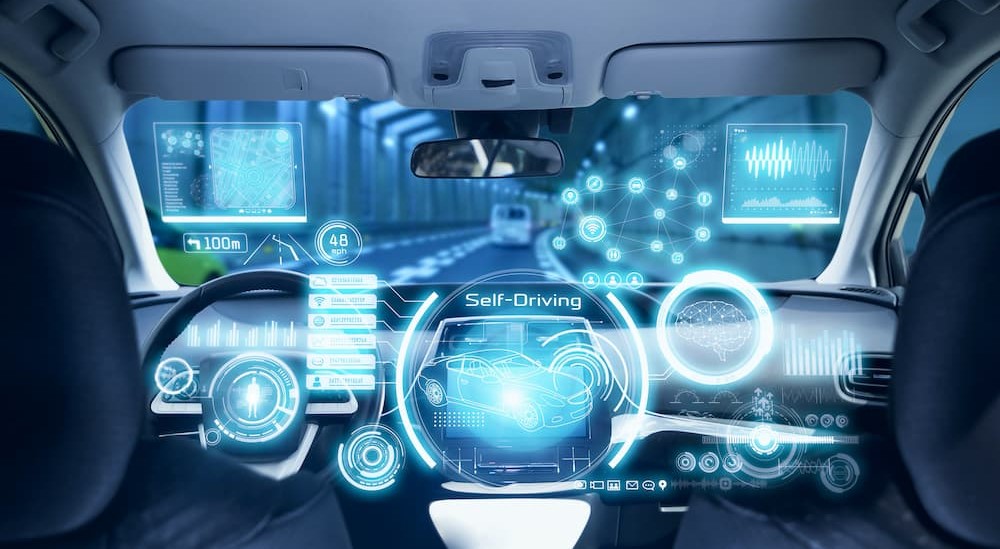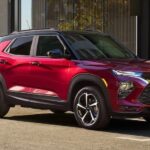Vehicle technology is constantly moving forward. We remember when a CD player in a car was considered groundbreaking. Now, we’ve blown so far past this point that, according to the most recent estimates, nearly half of all vehicles have ditched the onboard CD player in favor of more advanced audio technology. The same can be said of fuel injection, power windows, remote key fobs, and giant infotainment screens, all once revolutionary features that are now considered routine or may soon become obsolete.
The march is on for the next generation of vehicle technology that will change how we drive. Technology such as regenerative braking and heads-up display windshields that were considered futuristic a few years ago are already becoming widespread. What’s next? Today, we’re looking at three features in the pipeline: vehicle-to-vehicle communications, external airbags, and augmented reality. All three are starting to creep into modern vehicles to some degree. The question is when they’ll become commonplace, or at least something people no longer think twice about. Today, we hope to shed some light on the future of these features.
Vehicle-to-Vehicle Communications
Every time you drive a vehicle, it transmits information, from the speed you’re traveling to what song you’re listening to. For decades, direct communication has only happened within the vehicle. Any communication with other vehicles has been indirect, requiring the driver to see or hear something, like a turn signal or a siren, and then act accordingly.
But what if vehicles could talk to each other? That’s the idea behind vehicle-to-vehicle (V2V) communications. Also known as inter-vehicle communications or vehicle-to-vehicle technology, this involves a short-range network connecting compatible vehicles to a series of roadside units. In doing so, vehicles are aware of other nearby vehicles and what they are doing, even if the driver’s view is obscured.
As proposed, initial V2V technology would allow vehicles to broadcast safety messages and warnings to other vehicles, such as current speed, braking, traffic conditions, and impending turns. Over time, though, the belief is that V2V will progress to the point where a vehicle can act itself based on the information it receives. This would mirror the path vehicles are collectively taking toward semi-autonomous and autonomous driving.
V2V technology has been in the works for a while. Research began in the 1970s, and the National Highway Traffic Safety Administration (NHTSA) put out a report back in August 2014 examining the readiness of V2V technology for application. In January 2017, the NHTSA even proposed that all new light vehicles must have V2V communications. However, in November 2023, the NHTSA withdrew the proposal, citing new FCC regulations concerning the 5.9 GHz frequency band. While the entire band had been available for V2V technology since 1999, the FCC reallocated part of the band in 2020 towards expanding indoor WiFi instead.
One of the hurdles regarding V2V communications is affirming the communications standards on which to operate. With the new 5.9 GHz regulations, the WiFi option may need more work. Other automakers such as Volkswagen and Baidu (China) have been testing 5G LTE as a V2V technology roadway. Another major obstacle is making the technology safe, secure, and reliable. Many electronic and wireless devices in modern vehicles can potentially interfere with the V2V signal. Designers need to find a way to integrate V2V within the existing systems while deterring hackers from using it to steal sensitive data.
So far, only a few vehicles have dipped their toes in the water. The 2017 Cadillac CTS had V2V technology, as did the 2017 Mercedes E-Class and 2018 Mercedes S-Class. the Global Automakers Organization has also been supportive of V2V. Even so, intelligent transportation seems to be at a relative standstill, which is the final part of the puzzle. Petitioners challenged the initial FCC 5.9 GHz reallocation, and in siding with the FCC, DC Circuit Court Judge Justin Walker cited the lack of progress on V2V technology. In other words, regulators have grown impatient with promises and are now in “show me” mode. Though work is ongoing, it remains unclear when V2V communications will be ready for a widespread rollout.
External Airbags
Airbags inside a vehicle have long been a way to protect drivers in crashes. However, while the NHTSA estimates airbags saved more than 50,000 lives between 1987 and 2017, they are far from perfect. Conventional airbags deploy the same way regardless of who is seated and their positioning, leaving small adults and children at a much higher risk of head and neck injuries from the airbag impact. They also don’t do anything to reduce the impact forces of the crash on the vehicle itself, nor do they do anything to mitigate risks for pedestrians and animals.
One solution may be external airbags. German company ZF Friedrichshafen AG began developing a prototype in the late 2000s, and Popular Mechanics wrote a detailed report about them in 2019. The idea is simple. The side sills on the doors have one airbag each, and a series of sensors detect potential side collisions. When an impact is about to occur, the airbags deploy and inflate to roughly the front bumper height. The process takes about 0.1 seconds. Having airbags on the outside would help spread collision forces, which ZF says can lower injury risk by up to 30%.
As far as we know, ZF Friedrichshafen AG has not yet begun production on its external side airbags. Though they work well to reduce the force or side impacts, they still aren’t going to stop a driver or passenger from contacting the dashboard, window, or any other object. As such, they don’t replace regular airbags and safety belts. They are a supplement system at best. Another hurdle is that, as of now, there is no way to retrofit older vehicles with outside airbags. They must be built into the vehicle from the start, meaning automakers must get on board.
However, another automaker may have external airbags on the horizon. In 2022, Ford filed for and received a patent for an external airbag system that would be on the front of a vehicle for head-on impacts and pedestrian protection. They previously had filed a patent in 2015 for roof rack airbags to offer rollover protection. Although Ford has not yet announced when these systems will be seen on a vehicle, it’s a significant step forward.
Augmented Reality
Remember those commercials for VR headsets that were seemingly everywhere for a while? A similar technology is making its way to your vehicles, though thankfully, without the bulky headsets.
Augmented reality is already being used in automotive design. Notably, Ford adopted a 3D VR program in 2019 to develop its vehicles. This allows designers to create virtual models and prototypes, make real-time changes, and even do simulated testing, getting vehicles to market faster and less expensively. It’s almost exactly like how Ironman came up with everything from new suits to time travel.
What about when you’re behind the wheel? There are several ways augmented reality can change the driving experience. Intelligent real-time mapping would show signposts, terrain, areas to avoid, and more while adapting to the speed and distance. Automatic parking assistance would display projected lines when in reverse to help guide the driver where they are going and whether their vehicle will fit in a space. Some new vehicles even park themselves. Features like lane-keeping assist, front collision warnings, and weather alerts improve road safety. Augmented information and advertising as you drive could display bank account balances, upcoming movies, sneaker sales, and more. We’ll let you decide if this is a good thing. One use that is undoubtedly a good thing is helping technicians better identify automotive issues and providing instructions on how to repair them.
Unlike the other two technologies we’ve discussed, augmented reality in vehicles is arguably here. According to Market Research Future, the automotive AR market was valued at $1.2 billion in 2022, and it’s expected to reach $26 billion by 2032, an average annual growth of more than 40%. Mercedes-Benz began using augmented reality in their heads-up displays with the 2020 GLE, and Google has a “Live View” app that can do many of the same things. Certain AR features like parking assistance and collision warnings are borderline mandatory in new vehicles now, and we imagine more options aren’t far behind.
Driving Into the Automotive Future
Ever since the first automobile was completed in 1885, technology has moved at a brisk pace. We’ve gone from basic combustion engines to two turbochargers and plug-in hybrids. We’ve gone from a radio being an exciting feature to wirelessly connecting our smartphones without a second thought. The only constant is change, and with these new technologies either on the horizon or already making their presence felt, we’re looking forward to the next wave. We’ll continue to monitor the status of these and other features as the automotive industry roars into the next era.





